Director’s Corner

It’s now been nearly a year since my appointment as Interim Director of ATAP. 2019 started on a high note, with a BELLA Center publication of describing a new energy record for laser-plasma accelerators. Since then we had several very exciting highlights— please see the brief recap in the 2019 In Review article below.
The most recent highlight is a demonstration at Berkeley Lab’s Advanced Light Source of how machine learning using novel software tools that mimic neural networks can predictively feed information forward about beam-size fluctuations and cancel them before they occur. Machine learning and artificial intelligence are hot topics across many areas of science and we are very happy to see that this new approach has real impact in improving the performance of a workhorse accelerator. Conducted in collaboration with ALS Division staff, the demonstration exemplifies our long tradition of teamwork with the ALS user facility — a tradition that continues to grow with the ALS-Upgrade project (ALS-U).
Recently, the injector for the Linear Coherent Light Source (LCLS-II) at SLAC completed the formal transition to operations. The source had been developed in collaboration between Berkeley Lab and SLAC
Honors for our employees in 2019 included the election of Ji Qiang as the 29th Fellow of the American Physical Society in our Division’s history; the US Particle Accelerator School Prize for Cameron Geddes; and Berkeley Lab Director’s Awards for Eric Esarey (Scientific Achievement), Ian Pong (Scientific Achievement, Early Career), and Martha Condon (Service).
We communicated our results as lead or co-authors in 26 articles in the refereed literature and another 25 in conference proceedings and other unrefereed publications during fiscal 2019, including 9 articles in Physical Review journals, 4 Physical Review Letters, one in Nature, and a Nature Scientific Reports article. ATAP personnel were on the teaching teams for two US Particle Accelerator School courses and gave three CERN Accelerator School lectures.
Autumn brought us extremes of hot, dry winds and a pair of Public Safety Power Shutdowns by our electric utility. Among the literally hundreds of people who kept us safe and well-informed during these shutdowns of our main site and the methodical re-energization afterward were our Deputy Division Director for Operations, Asmita Patel, and EH&S Coordinator, Pat Thomas. All in all we handled the outages with the cooperation, selflessness, and team spirit that make Berkeley Lab the leader that it is.
I feel honored and humbled to look back on what we accomplished this year, and look forward to moving ahead strongly with new projects and initiatives in 2020.
FEATURED SCIENTIFIC ARTICLE
Machine Learning Helps Stabilize ALS Beams
Courtesy of ALS News, adapted from an article by Glenn Roberts, Jr., of Berkeley Lab Public Affairs

Profile of the electron beam at the ALS, represented as pixels measured by a charged-coupled device (CCD) sensor.
Researchers at Berkeley Lab’s Advanced Light Source (ALS), a synchrotron-light user facility, have shown that a form of artificial intelligence called “machine learning” can predict noisy fluctuations in the size of beams generated by synchrotron light sources and correct them before they occur. The work solves a decades-old problem and will allow researchers to fully exploit the smaller beams made possible by recent advances in light source technology.
A new approach to an old problem
Many synchrotron facilities deliver light to dozens of beamlines simultaneously. One side effect of this is that the motions of certain insertion devices (IDs) — undulators and wigglers with variable magnetic fields — cause the size of the electron beam to fluctuate, affecting the performance of other beamlines. Typically, corrections for these fluctuations are arrived at through the use of static physics models of the ID magnetic fields and time-consuming calibration measurements. However, with the advent of diffraction-limited storage rings with dramatically smaller beam sizes, much tighter control over beam stability is needed. Demanding experiments require photon-beam stability on time scales ranging from less than seconds to hours to ensure reliable data.
Here, for the first time, researchers have demonstrated that a neural network (a computerized pattern-recognition algorithm) can learn to predict the beam size during regular operation, given sufficient data about how ID configurations affect the beam. The predictions can then be used to neutralize beam perturbations before they occur (“feed-forward” vs. feedback correction), achieving an order-of-magnitude improvement in stability that fulfills the requirements for future light sources. Their work is described in S.C. Leemann, S. Liu, A. Hexemer, M.A. Marcus, C.N. Melton, H. Nishimura, and C. Sun, “Demonstration of machine learning-based model-independent stabilization of source properties in synchrotron light sources,” Physical Review Letters 123, 194801 (2019).
How to train your synchrotron

Vertical beam size (red) greatly improves when stabilization is on (yellow area). Blue trace is the parameter that is tuned to cancel out fluctuations.
Machine learning fundamentally requires two things: a reproducible problem and huge amounts of data. In this study, researchers fed electron-beam data from the ALS, including the positions of the IDs and the blips in electron-beam performance caused by ID adjustments, into a neural network. The algorithm was then able to learn the complex nonlinear relationships between the ID settings and vertical beam size and make corrections to negate the blips. The vertical beam size was stabilized to within 0.2 µm, or 0.4% of the beam size, compared to 2–3% without correction. The system is also fast: it can make corrections up to 10 times per second, although three times per second appears to be adequate for improving performance at this stage.
One key advantage of this approach is that data acquisition for retraining the neural network can be carried out continuously, even while the feed-forward system is active during a regular user run. Continuous retraining allows the neural network to constantly adapt to a drifting machine and changes in ID configurations during run periods, independent of static physics models.
Future-ready, steady light beams
Because the size of the electron beam mirrors the resulting light beam, this correction scheme also optimizes the light reaching beamline endstations. To demonstrate this, the researchers observed the effects of the algorithm on scanning transmission x-ray microscopy (STXM) images taken at Beamline 5.3.2.2. Highly sensitive to low-frequency variations in light intensity, STXM scans will exhibit banding in response to ID motion elsewhere in the ring. With the neural-network correction on, the bands disappeared.
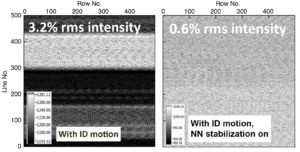
Banding that appears in STXM images during ID motion (left) disappears after neural-network (NN) stabilization is turned on (right).

Changchun Sun (from left), Hiroshi Nishimura, Simon C. Leemann, C. Nathan Melton, Alex Hexemer, and Y. Lu in the ALS control room. The team successfully demonstrated how machine-learning tools can improve the stability of photon-beam size via adjustments that largely cancel out problematic fluctuations — from a level of a few percent to 0.4 percent, with sub-micron precision.
This enhanced performance is also well suited for advanced x-ray techniques such as ptychography, which can resolve the structure of samples down to the level of nanometers, and x-ray photon correlation spectroscopy (XPCS), which is useful for studying rapid changes in highly concentrated materials that don’t have a uniform structure.
The technique could generally be applied to other light sources and will be especially beneficial for specialized studies enabled by the ALS Upgrade (ALS-U) Project, which will have an even higher demand for consistent, reliable light-beam properties.
ATAP Science and Technology in 2019
In a year that brought strong progress across ATAP’s diverse R&D portfolio, here are some of the highlights.
BELLA Center Sets New Laser-Plasma Accelerator Electron Energy Record
 February: By accelerating electrons to an energy of 7.8 GeV in just tens of centimeters, BELLA Center researchers have nearly doubled their own previous record for laser-driven particle acceleration, set in 2014 at 4.2 GeV.
February: By accelerating electrons to an energy of 7.8 GeV in just tens of centimeters, BELLA Center researchers have nearly doubled their own previous record for laser-driven particle acceleration, set in 2014 at 4.2 GeV.
|
|
Breakthrough in Computational Study of Laser-Plasma Interactions
 APRIL: A new 3D particle-in-cell (PIC) simulation tool developed by researchers from Lawrence Berkeley National Laboratory and CEA Saclay is enabling cutting-edge simulations of laser/plasma coupling mechanisms that were previously out of reach of standard PIC codes used in plasma research. More detailed understanding of these mechanisms is critical to the development of ultra-compact particle accelerators and light sources that could solve long-standing challenges in medicine, industry, and fundamental science more efficiently and cost-effectively.
APRIL: A new 3D particle-in-cell (PIC) simulation tool developed by researchers from Lawrence Berkeley National Laboratory and CEA Saclay is enabling cutting-edge simulations of laser/plasma coupling mechanisms that were previously out of reach of standard PIC codes used in plasma research. More detailed understanding of these mechanisms is critical to the development of ultra-compact particle accelerators and light sources that could solve long-standing challenges in medicine, industry, and fundamental science more efficiently and cost-effectively.
First Electrons from Gun at LCLS-II
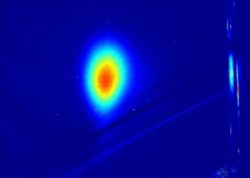 MAY: A new electron gun, designed and built at the U.S. Department of Energy’s Lawrence Berkeley National Laboratory (Berkeley Lab) to supply electrons for a next-gen X-ray laser at SLAC National Accelerator Laboratory in Menlo Park, California, fired its first electrons. It is just one of Berkeley Lab’s contributions to the multi-institutional LCLS-II project, which is an upgrade of SLAC’s Linac Coherent Light Source (LCLS) X-ray laser.
MAY: A new electron gun, designed and built at the U.S. Department of Energy’s Lawrence Berkeley National Laboratory (Berkeley Lab) to supply electrons for a next-gen X-ray laser at SLAC National Accelerator Laboratory in Menlo Park, California, fired its first electrons. It is just one of Berkeley Lab’s contributions to the multi-institutional LCLS-II project, which is an upgrade of SLAC’s Linac Coherent Light Source (LCLS) X-ray laser.
Phase Control Innovation Leads to Beam Teamwork
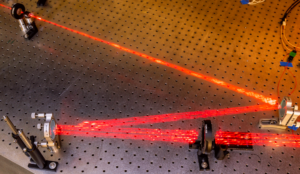 OCTOBER: A breakthrough in phase control of ultrafast lasers is a milestone for a Berkeley Lab-led effort to develop a high-power laser based on coherently combining many low-power pulses from fiber-optic lasers. This could evolve into a system for powering the next generation of laser-plasma accelerators, such as those of ATAP’s BELLA Center. A milestone in our work last year — coherent temporal beam combining — has now been complemented by an innovative beam control technique that holds the promise of adding coherent spatial combining.
OCTOBER: A breakthrough in phase control of ultrafast lasers is a milestone for a Berkeley Lab-led effort to develop a high-power laser based on coherently combining many low-power pulses from fiber-optic lasers. This could evolve into a system for powering the next generation of laser-plasma accelerators, such as those of ATAP’s BELLA Center. A milestone in our work last year — coherent temporal beam combining — has now been complemented by an innovative beam control technique that holds the promise of adding coherent spatial combining.
|
|
NEWS IN BRIEF
Guiding GARD: ATAP Hosts First Strategic-Roadmap Workshop
At the request of the Department of Energy’s Office of High Energy Physics, the accelerator community is developing a Strategic Roadmap for Accelerator and Beam Physics thrust of the HEP General Accelerator R&D (GARD) program. To solicit input to the roadmap, we hosted the first of two preparatory workshops December 9-10, 2019. (The second will be held in the Chicago area in March 2020.)
The goal of the workshops is to identify the Accelerator and Beam Physics needs that are key to fulfilling OHEP’s GARD mission and to develop a decadal roadmap for thrust activities that OHEP could support.
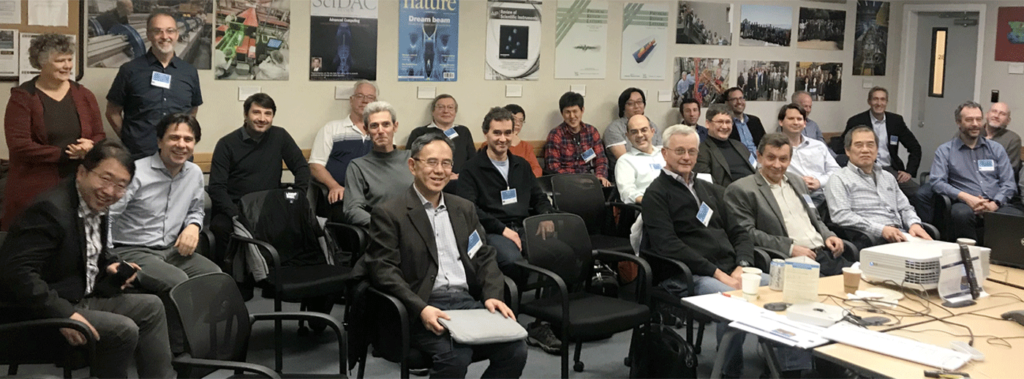
Stakeholders from across the national-laboratory complex participated
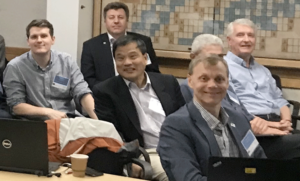
The Berkeley Lab workshop was organized into four Working Groups that focused on these topics:
(WG1) Single-particle dynamics, including nonlinearities, and spin dynamics. Conveners: S. Nagaitsev, L. Spentzouris, Y. Cai.
(WG2) High-brightness beam generation (including polarized beams), transport, manipulation and cooling. Conveners: J. Rosenzweig, P. Piot, A. Valishev
(WG3) Mitigation and control of collective phenomena: instabilities, space charge, beam-beam, beam-ion effects, wakefields, and coherent synchrotron radiation. Conveners: J. Power, Z. Huang, S. Cousineau
(WG4) Connections to other GARD roadmaps (cross-cutting WG1-3) [Conveners: J.-L. Vay, M. Conde, M. Hogan]
The upcoming Chicago-area workshop will emphasize four different topics:
(WG1) Advanced accelerator instrumentation and controls.
(WG2) Modeling and simulation tools (including energy deposition); fundamental theory and applied math.
(WG3) Early conceptual integration and optimization, maturity evaluation
(WG4) Connections to other GARD roadmaps; synergies with non-HEP
Jean-Luc Vay, head of ATAP’s Accelerator Modeling Program, organized the Workshop with the help of the ATAP operations team.
HONORS AND AWARDS
ATAP Staff Recognized With Director’s Awards

Left to right: Eric Esarey and Deputy Director for Research Horst Simon; Ian Pong with Associate Laboratory Director for Physical Sciences James Symons; ATAP Interim Division Director Thomas Schenkel and Martha Condon
At the annual Berkeley Lab Director’s Awards ceremony, three ATAP people received the Director’s Award for Exceptional Achievement: Eric Esarey for scientific achievement, Ian Pong for scientific achievement (early career category), and Martha Condon for service.
ATAP Deputy Division Director for Operations Asmita Patel and Environment, Safety, and Health Coordinator Patricia Thomas were members of the teams recognized for shepherding the Lab safely through the two multi-day Public Safety Power Shutdowns this fall.

Eric Esarey, Scientific
“In recognition of outstanding contributions to the science and technology of advanced accelerator concepts, and for his pioneering theoretical research in the physics of laser-plasma accelerators that has helped to enable the success of the BELLA Center.”
Senior Staff Scientist Eric Esarey, director of ATAP’s Berkeley Lab Laser Accelerator Center (BELLA), was honored in the Scientific category.
His focus is on understanding the fundamental principles of intense laser interactions with beams and plasmas, and on developing practical accelerators and radiation sources that rely on these principles. The laser-plasma accelerator (LPA) work at BELLA is among the most exciting frontiers of accelerator science; with the ability to generate gigavolts-in-centimeters accelerating gradients, LPAs offer the potential to reduce the size of future colliders for high-energy physics by orders of magnitude.
Nearer-term applications for these compact machines are already being explored, including compact accelerators for basic science, medicine, and defense, as well as drivers for future light sources, such as x-ray free-electron lasers.
Eric was one of the principal founders of this world-leading center. One of BELLA’s strengths is its integration of theory and computer modeling with experiment, and Eric has led the understanding of LPA physics and adjacent phenomena.
“We have had a big impact on each other’s careers,” writes Gérard Mourou, 2018 Nobel laureate in physics as co-developer of a revolutionary laser technique called chirped-pulse amplification or CPA. Mourou describes Eric as “a true pioneer in the field of laser-plasma accelerators” and goes on to call him “the world’s leading theorist on intense laser interactions with underdense plasmas {…} responsible for many of the key concepts and developments for laser-plasma accelerators and their applications.”
This expertise has been expressed in more than 220 refereed papers, including some considered landmarks in their field, and more than 100 invited and plenary talks at major international conferences. Eric is serving as general chair of the upcoming LBNL-hosted 2020 Advanced Accelerator Concepts Workshop.
Eric is also known as a mentor of colleagues at all levels from graduate students and postdocs through senior scientific staff. Virtually every member of the BELLA Center since 1998 has benefitted from his guidance, including over two dozen students, several who went on to full-time staff positions here.

Ian Pong, Scientific (Early Career)
“For technical and managerial excellence in pushing Nb3Sn superconductors and cables toward their performance limits in support of high-energy physics colliders and fusion-energy facilities through the U.S. Magnet Development Program and U.S. High-Luminosity LHC Accelerator Upgrade Project.”
Research scientist Ian Pong was recognized in the Scientific (Early Career) category.
The entire history of particle accelerators has been interwoven with the history of stronger, better, and more cost-effective magnets. Both as a technical expert in designing and applying an advanced superconductor called niobium-three-tin (Nb3Sn) and as a team and collaboration leader, Ian has helped achieve Berkeley Lab and DOE priorities at the frontier of magnet technology.
Among these priorities is the ongoing luminosity upgrade of CERN’s Large Hadron Collider, the first significant use of Nb3Sn in an accelerator. Another is the International Thermonuclear Experimental Reactor (ITER), the fusion-energy community’s flagship project, which will include the largest single Nb3Sn procurement in history.
In addition to his work as the Control Account Manager for Cable Winding and Magnet Testing in the High-Luminosity LHC Accelerator Upgrade Project, Ian represented the Physical Sciences Area — the LBNL associate laboratory directorate that includes the ATAP Division — on the LBNL Project Management Advisory Board.
Not only technical excellence but also interpersonal and leadership skills are crucial for today’s interdisciplinary, multi-institutional, and international team science. In a Critical Decision 2/3b review of the HL-LHC AUP, Ian was singled out for the exemplary quality of his management and delivery of his scope of work, and a reviewer described him as the best example for other subsystem managers.
Ian’s expertise is regularly sought by other institutions, helping maintain LBNL’s leadership as a center for superconducting magnet technology. He has a wide network of collaborators, having co-authored peer-reviewed papers with over 110 colleagues from more than 40 institutes.
Ian has also attracted high quality young researchers to join his team. Serving as both a leader and a role model for younger scientists, he has mentored an entry-level scientist, a postdoctoral fellow, two mechanical technicians, 1 QA/QC technician and 16 students.
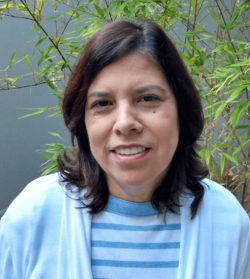
Martha Condon, Service
“In honor of exceptional and versatile service to the Laboratory over her four decade career as the lead administrator at the startup of multiple new and ongoing research programs in support of the DOE mission.”
An exemplar among the “hidden figures” who support our scientific excellence, ATAP Division Administrator Martha Condon has had a distinguished 39-year career in administrative support. Her achievements run the gamut from conference planning to property management, publications management, preparation of Building 71 for the BELLA Laser, facilitating complicated subcontracts with multiple institutions and businesses, assisting with the proposal process, and supervising/mentoring administrative staff.
She has supported the Division during several directorship transitions while also managing ongoing routine administrative functions, ensuring stewardship of resources and people. She has also been the startup administrator for multiple program and project launches.
Arranging and running events of all kinds and sizes, from small meetings to conferences, is another highlight among Martha’s diverse talents. Presently she is helping organize the 2020 Advanced Accelerator Concepts Workshop. She has also been an integral part of the logistical, planning, organization, and execution of our Safety Days, helping make them a success that in recent years has been joined and emulated by other Physical Sciences Divisions.
Deeply respected by scientific and operations staff within the Division and collaborating business partners across the laboratory, Martha’s award nomination elicited comments like “a treasure” with “superpowers”; “we just could not have done it without Martha’s tireless persistence and leadership
{…} everything worked without a hitch”; “I can’t begin to estimate the amount of administrative effort she has saved me and the Division staff by proactively solving a problem”; and “I knew we could rely on her for anything.”
Honoring the Unsung Heroes of PSPS Planning and Response
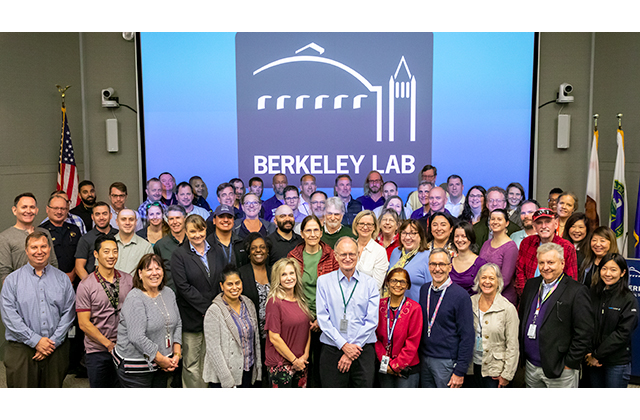
In order to prevent wildfires during extremes of high wind and dry weather, several public safety power shutdowns (PSPSs) were imposed this fall by northern California’s electric utility. Two of these area-wide events affected the main Laboratory site. Powering down a major laboratory with thousands of employees, nearly a hundred buildings, and every kind of complicated technical equipment took planning and methodical work, and a total of hundreds of our colleagues rose to the occasion. Lab Director Mike Witherell, Michael Brandt, Deputy Director, Operations, and Horst Simon, Deputy Director, Research, hosted thank-you events for the PSPS responders and saluted their efforts at the awards ceremony.
ENVIRONMENT, SAFETY, AND HEALTH: THE BOTTOM LINE
Reduce, Re-Use, and Recycle to Keep Science Sustainable
Here at Berkeley Lab we set ambitious goals for our environmental footprint, including recycling whatever we can and sending into the waste stream only what we must. But how are we doing? Sustainable Berkeley Lab recently conducted mini-audits of selected buildings, including ATAP’s Building 71. The results indicate where we are doing well and where we can find opportunities for progress.
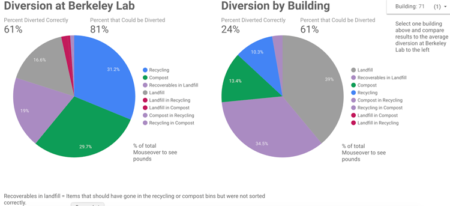
This figure summarizes the Building 71 mini-audit results. Click for an interactive version (choose Building 71 from the pulldown menu near its top right corner) and other resources to explore.
Some bright spots: We are great at putting only compostable materials in the compost bins, and at avoiding putting landfill materials into any recycling bins. At 0.8% by weight, we’re about Lab average at putting things that should have been compost into other recycling bins.
The biggest opportunity for improvement: Fully 34.5% by weight of what we send to the landfill (vs. a Lab average of 19%) should have been diverted from the waste stream into either compost or recycling, according to the auditors.
If it was alive in our lifetime, it can probably be composted

Creating a diversion: Food scraps and paper plate, used paper towels (found in Other Recycling and Landfill bins, respectively) should have gone into Compost
One of the most common items we might divert from the landfill stream, according to Sustainable Berkeley Lab’s Brie Fulton, is paper that is food-soiled or otherwise unsuitable for the paper-recycling bins. Our compost ends up in an industrial-scale facility that can handle things your home compost heap couldn’t.
Unfortunately our composting vendor has concluded that they cannot handle plant-oil-based plastics, and of course metal and regular plastics don’t go in the compost, but almost any sort of food scraps or food-related paper goods, including paper cups and plates, are fair game. This will go a long way toward meeting the Lab’s goal of diverting 90% of waste from the landfill.
Clean paper or cardboard should go to their highest and best use via the paper-recycling bin.
Keeping it clean
When it comes to Other Recyclables, Fulton points out the usefulness of making sure our diverted materials can actually be recycled. Rinsing a yogurt cup or other food container before putting it in the recycling bin is an example. Such items don’t need re-use levels of cleanliness, but the less they are contaminated, the more readily they will find a market, and the less processing they will need.
 The recyclability of plastics is a complicated issue. Signage at the receptacle, and the Waste Guide, show whether any particular plastic can go in the Other Recyclables bin or must be consigned to the landfill. Plastic films (plastic bags, cling/stretch wrap, candy wrappers, etc.) unfortunately must go into the landfill. (Consider alternatives to using them.) And styrofoam is not practical to recycle in our system (although clean packing peanuts can be re-used, so please put them in the special bin available in most mailrooms).
The recyclability of plastics is a complicated issue. Signage at the receptacle, and the Waste Guide, show whether any particular plastic can go in the Other Recyclables bin or must be consigned to the landfill. Plastic films (plastic bags, cling/stretch wrap, candy wrappers, etc.) unfortunately must go into the landfill. (Consider alternatives to using them.) And styrofoam is not practical to recycle in our system (although clean packing peanuts can be re-used, so please put them in the special bin available in most mailrooms).
Meeting sustainability: simple measures with high-multiplier benefits
Meetings, workshops, and other gatherings of people unfamiliar with local customs, or just the locations of recycling bins, are often a low point for our waste-diversion goals. When planning a meeting, please consider talking with the custodians about recycling bins — and just as you might show a safety slide so that people unfamiliar with the area know what to do in an emergency, you might show a recycling slide to encourage attendees to find the right bin. (And please make sure handouts are really needed by your attendees and agenda.)
Is centralizing the key to better recycling?
The individual office trash can is another opportunity to improve our waste-diversion performance. For practical reasons, its contents are generally destined for the waste stream rather sorting, and Fulton has observed that its convenience causes things to end up in the landfill unnecessarily. Consider “kicking the can” and instead taking your items to the appropriate central bins.
Half the contents Fulton finds in under-desk bins are food scraps and soiled paper, both of which can usually be composted. Getting them out of your office and into the central bins also makes your office less attractive to rodents and insect pests (more on this in the article below), so that’s a win-win.
Reduce, re-use, recycle… in that order
The best way to handle waste is to avoid making it in the first place. Can you use the same paper coffee cup all day at a meeting, or perhaps bring a reusable mug? Is a product made of (and packaged in) reusable or easily recyclable materials, rather than single-use material destined for a landfill, competitive in performance and price? Saving the Earth is done with decisions and actions throughout the complete lifecycle of a product.
To learn more…
• Explore the Sustainable Berkeley Lab website for in-depth information about how each of us can do great research with a lighter ecological footprint, and to learn what our waste-management professionals are doing behind the scenes. The Waste Guide is a great place to start.
• Sustainability Program Manager Brie Fulton is available to give a talk to your group and to consult on waste prevention and management for both ongoing work and special events.
|
|
Putting Out the Unwelcome Mat for Certain Holiday Guests
 At this time of year, mice and rats often try to come indoors. Rodents can leave messes and spread diseases… and they are notorious for gnawing on electrical wiring. Here are some tips on how to be a less inviting holiday host.
At this time of year, mice and rats often try to come indoors. Rodents can leave messes and spread diseases… and they are notorious for gnawing on electrical wiring. Here are some tips on how to be a less inviting holiday host.
• Keep nonperishable snack foods and earthquake supplies in a closed container they cannot easily gnaw though, not loose in a desk drawer or backpack.
• Remove any food items at the end of each day, and be sure that your under-desk trash can (if you use one) is free of food scraps.
• Don’t leave perishables in breakroom refrigeraters during the break. Bacteria and mold won’t be taking a holiday!
• Wipe down desktops, tables, and counter tops after food has been consumed. Mere scraps and crumbs by our standards can be a feast for something the size of a mouse.
• Let your custodians know if you are planning office parties, so they can promptly remove extra trash.
• Be sure that the last of the trash bags go to outside dumpsters before a building is left unoccupied over the break.
All of these precautions will also help protect against ants.
If you do see rodents or other pests, contact your Building Manager or the Work Request Center to request Pest Control services.
Do not attempt to clean up dead rodents or droppings. Contact your custodians. They are trained in how to clean up safely.
Let’s Think On Our Feet This Winter
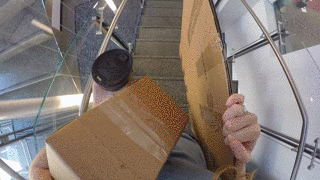 Walk Mindfully, Pocket Your Phone, and Hold the Rail! | As we approach the longest night of the year here in the Northern Hemisphere, with rain often in the picture, leaves on the sidewalks and stairways, and holiday decorations almost within easy reach, this is a crucial time for slip, trip, and fall prevention both at the Lab and at home. Let’s walk (and drive and bike) mindfully, which includes paying attention to the physical world around us rather than the virtual world in handheld devices. |  |
||
Movie courtesy Horst Simon, LBNL Deputy Director for Research, and Sponsor, Berkeley Lab Safety Culture Work Group. Poster by Lucky Cortez, UCSF, formerly of the ATAP Operations Team.
Use handrails on stairways and steep walkways, and clean up slippery spills before others come upon them unawares.
Using ladders properly is important at any time of year. For more information on safe use of ladders and stepstools, contact Alyssa Brand, ext. 7246.
Further tips to keep easily prevented accidents from spoiling the festivities are available from the National Safety Council and the US Fire Administration.
Here’s wishing you and yours a happy holiday season and a safe return in the new year!